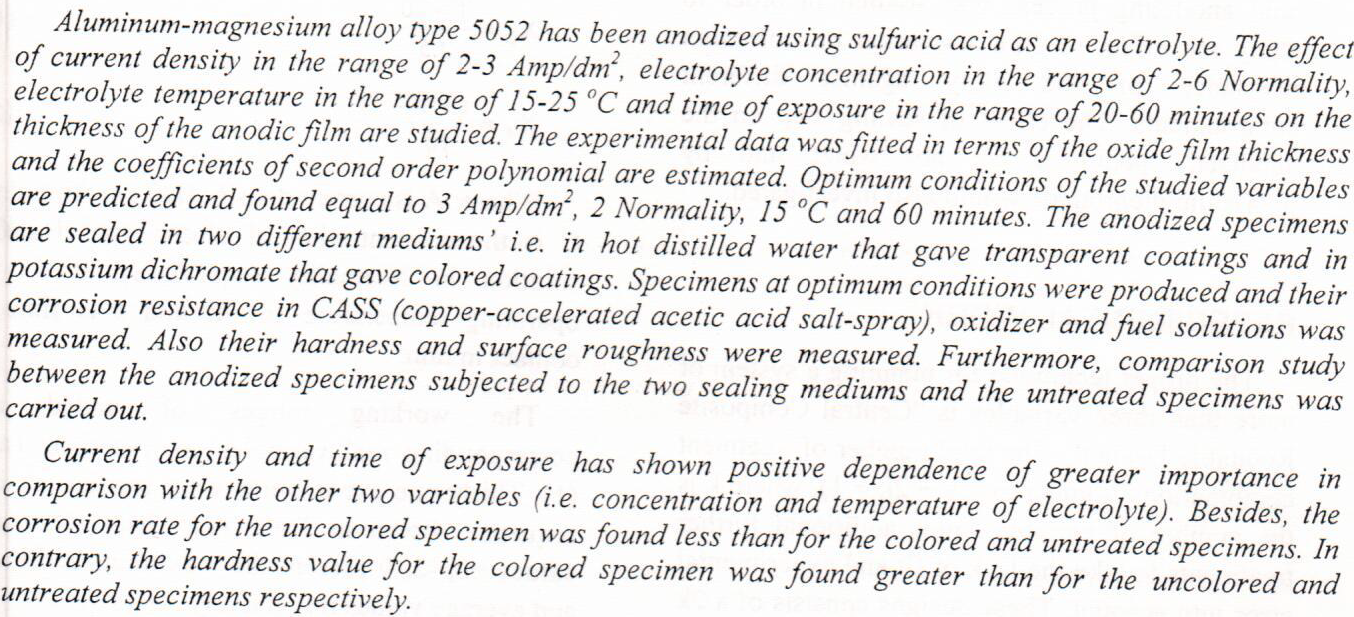
A tungsten inert gas (TIG) welding is one of the most popular kinds of welding used to join metals mainly for aluminum alloys. However, many challenges may be met with this kind of joining process; these challenges arise from decay of mechanical properties of welded materials. In the present study, an attempt was made to enhancing the mechanical properties of TIG weld joint of 6061-T6 aluminum alloy by hardening the surfaces using shoot peening technique. To optimize the shoot peening process three times of exposure (5, 10, and 15) min. was used. All peened and unpeened, and welded and unwelded samples were characterized by metallographic test to indicate the phase transformation and modification in microstructure occurring d
... Show MoreIn the present study, a powder mixture of elements Ti and Ni was mechanically alloyed in a high energy ball mill. Microstructure of the nanosized amorphous milled product in different stages of milling has been characterized by X- ray diffraction, scanning electron microscopy and differential thermal analysis. We found that time of mechanical alloying is more significant to convert all crystalline structure to the amorphous phase. Nanocrystalline phase was achieved as a result of the mechanical alloying process. The results also indicates that the phase transformation and the grain size occurs in these alloys are controlled by ball milling time
This research deals with the effects of welding variables using MIG/MAG spot by using Argon (Ar) gas and CO2 to show their effect on the mechanical characteristics and microstructure of low alloy steel type DIN15Mo3 and determine the optimum condition for the process of welding ; current & time. The results show the possibility of using CO2 and also Ar in low alloy steel welding with a little decrease in the shear force of not more than 13% for 4mm thickness and time 2sec. The shear force increased when using Ar instead of CO2 to be , The shear force reach 36KN when using Ar at 2mm thickness time of 8 sec and current of 220 Amp. , when used CO2 instead of Ar d
... Show MoreNuclear structure of 29-34Mg isotopes toward neutron dripline have been investigated using shell model with Skyrme-Hartree–Fock calculations. In particular nuclear densities for proton, neutron, mass and charge densities with their corresponding rms radii, neutron skin thicknesses and inelastic electron scattering form factors are calculated for positive low-lying states. The deduced results are discussed for the transverse form factor and compared with the available experimental data. It has been confirmed that the combining shell model with Hartree-Fock mean field method with Skyrme interaction can accommodate very well the nuclear excitation properties and can reach a highly descriptive and predictive power when investiga
... Show MoreThis study aims to model the flank wear prediction equation in metal cutting, depending on the workpiece material properties and almost cutting conditions. A new method of energy transferred solution between the cutting tool and workpiece was introduced through the flow stress of chip formation by using the Johnson-Cook model. To investigate this model, an orthogonal cutting test coupled with finite element analysis was carried out to solve this model and finding a wear coefficient of cutting 6061-T6 aluminum and the given carbide tool.
 (12)
(12)
 (9)
(9)
Recently on the dermatological fields, the serum levels and the roles of Zn, Cu and Mg have been studied especially in acne vulgaris, but the results were controversial. The aim of the present study is to investigate a relationship between the severity of acne and the serum levels of zinc (Zn), copper (Cu) and magnesium (Mg) and to demonstrate the status of serum levels of zinc, copper, and magnesium in Iraqi male patients with acne vulgaris and to compare it with those of healthy controls.This case controlled study was conducted in the Department of Dermatology and Venerology and in the Poisoning Consultation Center of Baghdad Teaching Hospital between May 2009 to January 2010. Forty- five male patients with acne vulgaris, their a
... Show MoreThe synthesis of nanoparticles (GNPs) from the reduction of HAuCl4 .3H2O by aluminum metal was obtained in aqueous solution with the use of Arabic gum as a stabilizing agent. The GNPs were characterized by TEM, AFM and Zeta potential spectroscopy. The reduction process was monitored over time by measuring ultraviolet spectra at a range of λ 520-525 nm. Also the color changes from yellow to ruby red, shape and size of GNP was studied by TEM. Shape was spherical and the size of particles was (12-17.5) nm. The best results were obtained at pH 6.
 (4)
(4)
 (2)
(2)
